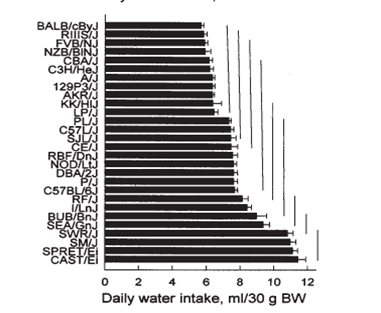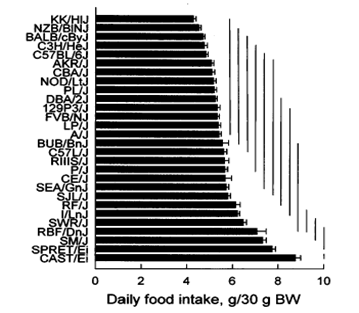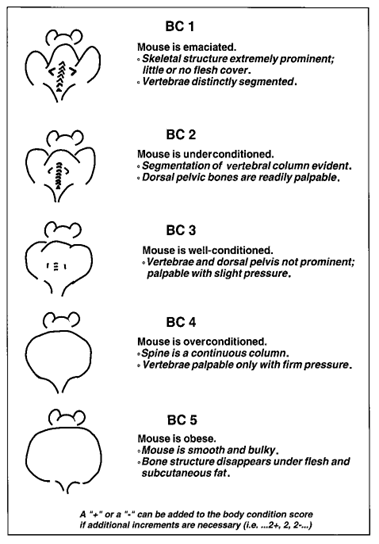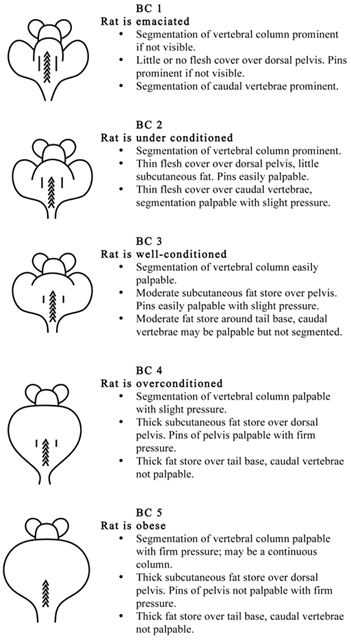IG034: Food & Fluid Regulation in Rodents
IACUC Guideline Number: IG034, Approved By: IACUC, Approval Date: 9/12/2024, Version: 2
This guideline will outline important issues to be addressed in protocols that propose limitations in animal access to food/fluid. Limitations on routine access to food and/or fluid (restriction or regulation) may be used in research settings for (1) studies that use food/fluid consumption to motivate animals to perform novel or learned tasks, (2) studies of the motivated behaviors and physiologic mediators of hunger and thirst, and (3) homeostatic regulation of energy metabolism or food balance.
The objective when these studies are being planned and executed should be to use the least regulation necessary to achieve the scientific objectives while maintaining animal well-being. In order to accomplish this objective, the following must always be considered and adequately described in the IACUC protocol:
- The necessary level of regulation
- Potential adverse consequences of regulation
- Methods to assess the health and well-being of the animals under regulation
Definitions
- Ad libitum: Access to a continuous supply of food and water; animals can eat and drink as much and as often as they want.
- Baseline weight: Weight taken prior to start of limited diet or fluid access.
- Deprivation: Complete withholding of food > 24 hours; withholding water > 12 hours. Deprivation of water >12 hours, or food withholding >24 hours, requires IACUC approval.
- Dehydration: A fluid deficit in body tissues; signs of dehydration in rodents include skin tenting, sunken eyes, hunched posture, decreased activity.
- Diet Regulation: The act of controlling an animal’s access to water or food (e.g. providing free access to feed for 12 hours of every 24 hours). The amount received may be equal to or less than the average daily ad libitum water and food consumption.
- Diet Restriction: The act of controlling the amount of water or food an animal receives and when the animal receives it. The amount is less than the average daily ad libitum water and food consumption.
- Average daily consumption: The average amount of water or food that an animal consumes per day ad libitum during a two-week period. This is necessary when a percentage of ad libitum water or food consumption is used to calculate the amount of fluid or food given during restriction (See Appendix A).
Scientific Justification
Scientific justifications are to be provided by the Principal Investigator in approved protocols for using regulation or restriction of food or fluid in rodents. This justification should include an explanation as to why ad libitum feeding/watering cannot be used and to provide rationale for the level and length of time the regulation or restriction is proposed. In accordance with the Guide for the Care and Use of Laboratory Animals (2011), in the case of conditioned response research protocols, use of a highly preferred food or fluid as a positive reinforcement is recommended. The justification should also include the appropriateness of the life stage to be studied, reasons why positive reinforcement cannot be considered, and a description of how personnel will be trained in administering food/fluid regulation or restriction and monitoring animal well-being.
Determining Ad Libitum Values
For any study requiring chronic (over 24 hour) regulation, the investigator should provide the normal range of ad libitum intake for the same background strain, sex and age group used in the study. Published values for the same age, sex, background strain, and weight may be used in lieu of in-house determination. See Appendix B for a sample of published data regarding common strains of mice used in research for water and food values.
Determining Level of Regulation
In the procedure description, the investigator should provide the formula used for the proposed diet restriction, the type of feed to be provided, the target end body weight for animals undergoing restriction, and the method used for determining this target weight (e.g., comparison to baseline weight, age- or strain-matched controls, published growth charts). For example, “Food restriction equal to 70% of ad libitum intake until the rodent is at 80% body weight of peer controls.”
Acute water deprivation up to 24 hours will result in clinical dehydration, but deprivation in excess of 24 hours is not permitted. Rodents may be placed under chronic water restriction of as much as 50% of the ad libitum daily ration if it is imposed over an interval of up to 7 days.
Rodents should be acclimated over 3 days to new scheduling paradigms unless specifically approved by the IACUC. Generally, it is recommended that animals be gradually reduced to a target weight and acclimated to the feeding schedule over some period, such as several weeks, to mitigate the stress response. Consideration should be made to allow food and water to be available concurrently, as rodents typically do not eat without available water. Offered food should be nutritionally complete for the species. For animals undergoing diet regulation, access to food and/or water must be for 15 minutes at a minimum. Restricted levels should not exceed 30% of food or 50% of water provided ad libitum. Food/fluid restriction is not recommended in rodents under 14 weeks of age.
Monitoring and Documentation
Animals on regulation or restriction must be monitored daily and weighed at least twice weekly, but it is encouraged to do so as often as study design permits. Weight should be compared to either age- and strain-matched controls or to the baseline body weight (if an adult). Additionally, a body condition score (BCS) system should be used to evaluate the animals. See Appendix C for a diagram explaining the BCS system and how it differs between mice and rats.
Food and water availability should be recorded daily during any time period that diet regulation or restriction is being conducted. Affected housing cages should have appropriately filled-out, orange PI care flags in place and PI care sheets should be maintained at the room level. Records of daily monitoring should include the following information:
- General information (i.e. protocol number, animal identification number, Principal investigator, contact person, contact phone number and/or email)
- Baseline weight (before restriction period began)
- Date (daily documentation is necessary)
- Weight and BCS (at least twice weekly)
- Health assessment (including hydration status, i.e., skin turgor, posture, coat appearance, presence of urine and feces in cage)
Endpoints
Specific humane endpoints that would require intervention must be clearly stated in the protocol. See Appendix D for sample humane endpoint assessment documentation.
For food restriction, a rodent may not lose more than 20% of age-strain-sex matched controls or baseline body weight (if adult).
- After the intended percentage of weight loss has been achieved the daily food allowance should be increased to prevent additional weight loss. Restriction or regulation cannot be attempted again until the animal weighs at least 80% of its original weight.
- If an animal has a body condition score of ≤ 2 out of 5, appears listless, hunched, or is showing signs of pain/distress, discontinue restriction and contact the CAR veterinary care staff (carvets@msu.edu).
Rodents on fluid restriction with a weight loss of 10% of baseline weight should be considered clinically dehydrated and should be treated as outlined below.
- Any rodent appearing dehydrated (e.g. displaying listlessness/inactivity, increased “skin tent” (loss of elasticity when skin between the shoulder blades is gently lifted upwards and released), and/or sunken eyes must have drinkable fluid support provided immediately by supplying a measured volume of fluid. Enough fluid should be provided to allow the animal to freely drink without interruption.
- In addition, alternative fluid sources (e.g. hydrogel, moistened food, 0.5-2 mL subcutaneous sterile lactated ringers or saline (0.9% NaCl)) must be administered.
- Lab members involved in fluid regulation must be trained to be able to identify dehydration and be comfortable giving subcutaneous fluids.
- If a rodent appears dehydrated, listless, hunched, or showing signs of pain/distress, contact the CAR veterinary care staff (Email CAR Veterinary Staff at carvets@msu.edu).
Exceptions
If there is a scientific necessity to manage food and fluid regulation or restriction in your model in such a way that is different than the parameters described above, an exception to your animal use protocol is needed. NOTE: Deprivation of water >12 hours, or food withholding >24 hours, requires IACUC approval.
References
Bachmanov AA, Beauchamp GK, Tordoff MG. 2002. Voluntary consumption of NaCl, KCl, CaCl2 and NH4Cl solutions by 28 mouse strains. Behav Genet 32:445-57.
Barkus C, Bergmann C, Branco T, Carandini M, Chadderton PT, Galiñanes GL, Gilmour G, Huber D, Huxter JR, Khan AG, King AJ, Maravall M, O'Mahony T, Ragan CI, Robinson ESJ, Schaefer AT, Schultz SR, Sengpiel F, Prescott MJ. 2022. Refinements to rodent head fixation and fluid/food control for neuroscience. J Neurosci Methods 381:109705.
Bekkevold CM, Robertson KL, Reinhard MK, Battles AH, Rowland NE. 2013. Dehydration parameters and standards for laboratory mice. J Am Assoc Lab Anim Sci 52:233-39.
Hickman DL, Swan M. 2010. Use of a body condition score technique to assess health status in a rat model of polycystic kidney disease. J Am Assoc Lab Anim Sci 49:155-59.
National Research Council. 2003. "Food and Fluid Regulation." Guidelines for the Care and Use of Mammals in Neuroscience and Behavioral Research. Washington, D.C.: The National Academies Press, 49-61.
National Research Council. 2011. “Food and Fluid Regulation.” Guide for the Care and Use of Laboratory Animals. 8th ed. Washington, D.C.: The National Academies Press, 30-31.
Rowland NE.. 2007. Food or fluid restriction in common laboratory animals: balancing welfare considerations with scientific inquiry. Com Med 57:149-60.
Toth LA, Gardiner TW. 2000. Food and water restriction protocols: physiological and behavioral considerations. Contemp Top Lab Animal Sci 39:9-17.
Appendix A: Average Food and Water Consumption in Rodents
| Species | Daily Water Consumption | Daily Feed Consumption |
|---|---|---|
| Mouse | 15 ml/100 g BW | 15 g/100 g BW |
| Rat | 8-11 ml/100 g BW | 5 g/100 g BW |
| Guinea Pig | 10 ml/100 g BW | 6 g/100 g BW |
Baumanns V. 1999. The laboratory mouse. In: Poole T, editor. The UFAW handbook on the care and management of laboratory animals, 7th ed. Oxford (UK): Blackwell Science.
Harkness JE, Wagner JE, Turner PV, VandeWoude S, Wheler CL. 2010. The Biology and Medicine of Rabbits and Rodents, 5th ed. Ames (IA): Blackwell Publishing.
Otto GM, Franklin CL, Clifford CB. 2015. Biology and diseases of rats. In: Fox, JG, Anderson LC, Otto GM, Pritchett-Corning KR, Whary MT, editors. Laboratory animal Medicine, 3rd ed. San Diego (CA): Academic Press.
Appendix B: Published Graphs of Water and Food Intake in 28 Common Mouse Strains


Bachmanov AA, Beauchamp GK, Tordoff MG. 2002. Voluntary consumption of NaCl, KCl, CaCl2 and NH4Cl solutions by 28 mouse strains. Behav. Genet. 32:445–457.
Appendix C: Body Condition Scoring (BCS) Charts for Mice and Rats


Hickman DL, Swan M. 2010. Use of a body condition score technique to assess health status in a rat model of polycystic kidney disease. J Am Assoc Lab Anim Sci. 49(2):155-9.
Ullman-Culleré, MH, Foltz, C.J. 1999. Body Condition Scoring: A Rapid and Accurate Method for Assessing Health Status in Mice. Comp Med. 49 (3): 319-323.
Appendix D: Assessment of Pain and Distress in Rodents
Visual Activity
- Inactive: a (mild), b (moderate), c (serious)
- Isolated: Y (yes), N (no)
- Walking on tiptoe: Y (yes), N (no)
- Hunched posture: a (mild), b (moderate), c (serious)
- Pinched face: a (mild), b (moderate), c (serious)
- Unkempt cost: a (mild), b (moderate), c (serious)
- *Type of breathing: R = rapid; S = shallow; L = labored; n = normal
- Twitching: a (mild), b (moderate), c (serious)
- Licking at incision (if present): a (mild), b (moderate), c (serious)
- Stretching: 0: a (mild), b (moderate), c (serious)
Behavior/Appearance on Handling
- Not inquisitive and alert: a (mild), b (moderate), c (serious)
- Not eating: a (mild), b (moderate), c (serious)
- Not drinking: a (mild), b (moderate), c (serious)
- Vocalization on gentle palpation: a (mild), b (moderate), c (serious)
- Pale or sunken eyes: a (mild), b (moderate), c (serious)
- Dehydration: a (mild), b (moderate), c (serious)
- Distended abdomen/swollen: a (mild), b (moderate), c (serious)
- ** Diarrhea: 0 to 3 (m +/-b)
Scoring Details
* Breathing: R = rapid; S = shallow; L = labored; n = normal
**0 = normal; 1 = loose feces on floor; 2 = pools of feces on floor; 3 = active defecation +m = mucus; b = blood
Y = Yes N = No
Scoring Symbols
- Mild
- Moderate
- Serious
Humane Endpoints and Actions
- Any animal showing signs of coma within the first 24‐48 hr. will be euthanized.
- Any animals losing more than 20% of its start weight at any time will be euthanized.
- Any animal showing tiptoe or slow ponderous gait will be euthanized or staff will confer with the veterinarian staff.
- Inform veterinarian and principal investigator if more than one clinical sign occurs.
Stokes, WS. 2002. Humane endpoints for animals used in biomedical research and testing. ILAR J. 41:59-126.

